-
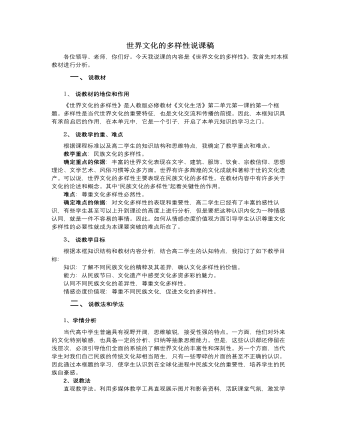
人教版高中政治必修3世界文化的多样性说课稿
1、 说教材的地位和作用《世界文化的多样性》是人教版必修教材《文化生活》第二单元第一课的第一个框题。多样性是当代世界文化的重要特征,也是文化交流和传播的前提。因此,本框知识具有承前启后的作用,在本单元中,它是一个引子,开启了本单元知识的学习之门。2、 说教学的重、难点根据课程标准以及高二学生的知识结构和思维特点,我确定了教学重点和难点。教学重点:民族文化的多样性。确定重点的依据:丰富的世界文化表现在文字、建筑、服饰、饮食、宗教信仰、思想理论、文学艺术、风俗习惯等众多方面。世界有许多辉煌的文化成就和著称于世的文化遗产。可以说,世界文化的多样性主要表现在民族文化的多样性。在教材内容中有许多关于文化的论述和概念。其中“民族文化的多样性”起着关键性的作用。难点:尊重文化多样性必然性。
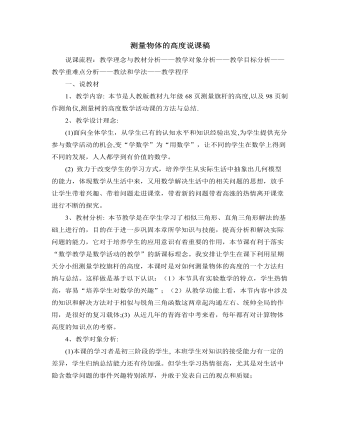
北师大版初中数学九年级下册测量物体的高度说课稿
(三)解释、应用和发展问题4:如果测量一座小山的高度,小山脚下还有一条河,怎么办? (教师巡视课堂,友情帮助 ,让学生参照书本99页,用测角仪测量塔高的方法.这个物体的底部不能到达。)(1)请你设计一个测量小山高度的方法:要求写出测量步骤和必须的测量数据(用字母表示),并画出测量平面图形;(2)用你测量的数据(用字母表示),写出计算小山高度的方法。过程: (1) 学生观察、思考、建模、自行解决(3) 学生间讨论交流后,教师展示部分学生的解答过程(重点关注:1.学生能否发现解决问题的途径;学生在引导下,能否借助方程或方程组来解决问题;学生的自学能力.2.关注学生克服困难的勇气和坚强的意志力。3.继续关注学生中出现的典型错误。)(设计意图: 让学生进一步熟悉如何将实际问题转化成数学模型,并能用解直角三角形的知识解决简单的实际问题,发展学生的应用意识和应用能力。

北师大版初中数学九年级下册垂直与弦的直径说课稿
至此,估计学生基本能够掌握定理,达到预定目标,这时,利用提问形式,师生共同进行小结。五、几点说明1、板书设计:为了使本节课更具理论性、逻辑性,我将板书设计分为三部分,第一部分为圆的轴对称性,第二部分为垂径定理,第三部分为测评反馈区(学生板演区)。2、由于垂径定理在圆一章中的重要性,所以这节课只讲了定理而没有涉及逆定理。3、设计要突出的特色:为了给学生营造一个民主、平等而又富有诗意的课堂,我以新数学课程标准下的基本理念和总体目标为指导思想,在教学过程中始终面向全体学生,依据学生的实际水平,选择适当的教学起点和教学方法,充分让学生参与教学,在合作交流的过程中,获得良好的情感体验。通过“实验--观察--猜想--证明”的思想,让每个学生都有所得,我注意前后知识的链接,进行各学科间的整合,为学生提供了广阔的思考空间,同时让学生利用所学知识解决实际问题,感受理论联系实际的思想方法。
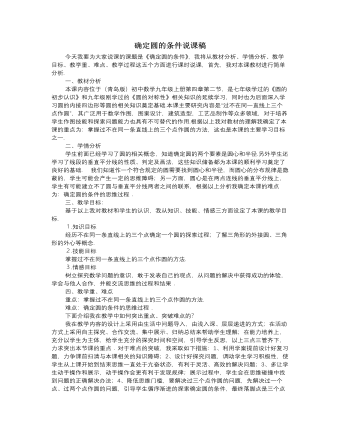
北师大版初中数学九年级下册确定圆的条件说课稿
设计说明:设计这组测验为了反馈学生学习情况,第1题较简单,也是为了让提高学生学习士气,体会到成功的快乐;第2题稍微有点挑战性,利用直角三角形外心位置规律解答,也满足不同层次学生的不同需求.教师可们采用抢答方式调动学生积极性,学生抢答,师生共同反馈答题情况,教师最后出示正确答案并做总结性评价.环节十:布置作业课件演示: 拓展延伸1.思考:经过4个(或4个以上的)点是不是一定能作圆?2.作业:A层 课本118页习题A组1,2,3; B层 习题B组.设计说明:设计第1题的原因保证了知识的完整性,学生在探究完三个点作圆以后,肯定有一个思维延续,不在同一直线上三个点确定一个圆,四个点又会怎样?四个点又分共线和不共线两种情况,不共线的四点作圆问题又能用三点确定一个圆去解释,本题既应用了新学知识,又给学生提供了更广泛地思考空间.第2题,主要是让学生进一步巩固新学知识,规范解题步骤. 在作业设计时,既面向全体学生,又尊重学生的个体差异,以掌握知识形成能力为主要目的.
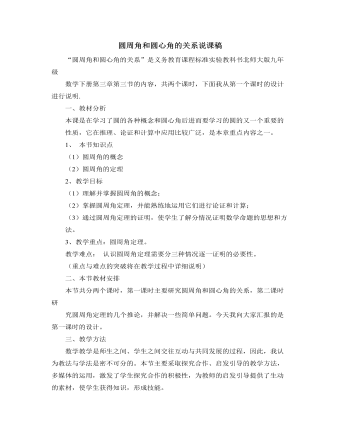
北师大版初中数学九年级下册圆周角和圆心角的关系说课稿
(设计意图:因为圆中有关的点、线、角及其他图形位置关系的复杂,学生往往因对已知条件的分析不够全面,忽视某个条件,某种特殊情况,导致漏解。采用小组讨论交流的方式进行要及时进行小组评价。)(3) 议一议( 如图,OA、OB、OC都是圆O的半径∠AOB=2∠BOC, 求证:∠ACB=2∠BAC。)(设计意图:通过练习,使学生能灵活运用圆周角定理进行几何题的证明,规范步骤,提高利用定理解决问题的能力。)(三)说小结首先,通过学生小组交流,谈一谈你有什么收获。(提示学生从三方面入手:1、学到了知识;2、掌握了哪些数学方法;3、体会到了哪些数学思想。)然后,教师引导小组间评价。使学生对本节内容有一个更系统、深刻的认识,实现从感性认识到理性认识的飞跃。(四)、板书设计为了集中浓缩和概括本课的教学内容,使教学重点醒目、突出、合理有序,以便学生对本课知识点有了完整清晰的印象。我只选择了本节课的两个知识点作为板书。
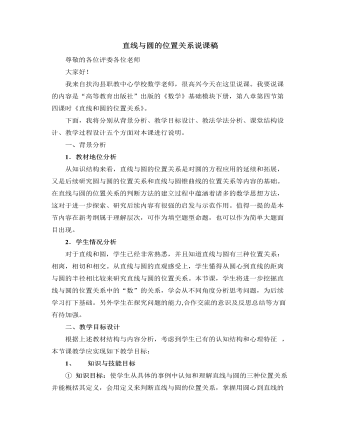
北师大版初中数学九年级下册直线与圆的位置关系说课稿
设计意图这一组习题的设计,让每位学生都参与,通过学生的主动参与,让每一位学生有“用武之地”,深刻体会本节课的重要内容和思想方法,体验学习数学的乐趣,增强学习数学的愿望与信心。4.回顾反思,拓展延伸(教师活动)引导学生进行课堂小结,给出下列提纲,并就学生回答进行点评。(1)通过本节课的学习,你学会了哪些判断直线与圆位置关系的方法?(2)本节课你还有哪些问题?(学生活动)学生发言,互相补充。(教师活动)布置作业(1)书面作业:P70练习8.4.41、2题(2)实践调查:寻找圆与直线的关系在生活中的应用。设计意图通过让学生课本上的作业设置,基于本节课内容和学生的实际,对课后的书面作业分为三个层次,分别安排了基础巩固题、理解题和拓展探究题。使学生完成基本学习任务的同时,在知识拓展时起激学生探究的热情,让每一个不同层次的学生都可以获得成功的喜悦。
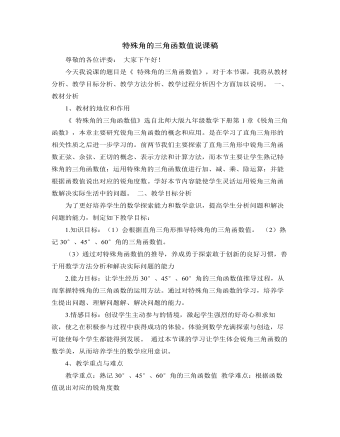
北师大版初中数学九年级下册特殊角的三角函数值说课稿
教学过程我主要分为六部分:一、新课引入,二、探究新知 ,三、巩固新知,四、感悟收获,五、布置作业,六、板书设计 (一)、新课引入教师提问:一个直角三角形中,一个锐角正弦、余弦、正切值是怎么定义的? sinA如图在 Rt△ABC中,∠C=90°。(1)a、b、c三者之间的关系是 ,∠A+∠B= 。 (2)sinA=sinB= , cosB= ,tanB= 。 (3)若A=30°,则B(4)sinA和cosB有什么关系?____________________;【设计意图】回顾上节课所学的内容,便于后面教学的开展。 (二)、探究新知活动一、探索特殊角的三角函数,并填写课本表格[问题] 1、观察一副三角尺,其中有几个锐角?它们分别等于多少度? [问题] 2、sin30°等于多少呢?你是怎样得到的?与同伴交流. [问题] 3、cos30°等于多少?tan30°呢? [问题] 4、我们求出了30°角的三个三角函数值,还有两个特殊角——45°、60°,它们的三角函数值分别是多少?你是如何得到的? 1、特殊角的三角函数值表:

北师大版初中数学九年级下册船有触礁的危险吗说课稿
5、板书设计 §1.4船有触礁的危险吗 一、船布触礁的危险吗 1.根据题意,画出示意图.将实际问题转化为数学问题. 2.用三角函数和方程的思想解决关于直角三角形的问题. 3.解释最后的结果. 二、测量塔高 三、改造楼梯 五布置课后作业: 习题1.6第12 3题 六、设计说明 具有现实意义和挑战性的内容的设计,激发学生的学习兴趣,使学生乐学。 开放性实践问题和分层作业的设置,满足每个学生的学习需求,使学生愿学。 多样的学习方式和适时引导,提高学生的学习质量,使学生能学。 背景多样,层层递进,适时反思,发展学生的数学思维能力,使学生活学。 当学生乐学、愿学、能学、活学时,就将学会学习,将学习当成乐趣,作为生命中不可或缺的部分,也为学生终生学习奠定良好的基础。
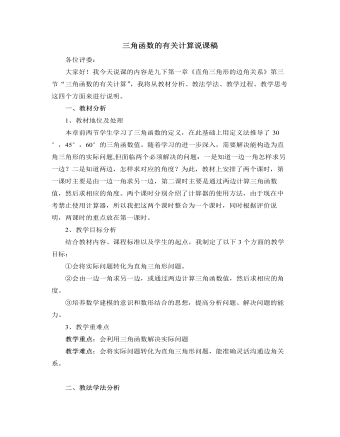
北师大版初中数学九年级下册三角函数的有关计算说课稿
设计意图:最后是当堂训练,目标检测,这一环节要尽量让学生独立完成,使训练高效,在学生训练时教师要巡回辅导,重点关注课堂表现不太突出的学生,由于本课时内容多,训练贯穿课堂始终,加上不能使用计算器,因此课堂节奏难于加快,所以当堂训练的时间预估不足。四、教学思考1.教材是素材,本节课对教材进行了全新的处理和大胆的取舍,力求创设符合学生实际的问题情境,让学生经历从实际问题中抽象出锐角三角函数模型的过程,发展了学生的应用意识及分析问题解决问题的能力,培养了学生的数学建模能力及转化的思维方法。2.充分相信学生并为学生提供展示自己的机会,课堂上要把激发学生学习热情和获得学习能力放在教学首位,通过运用各种启发、激励的语言,以及小组交流、演板等形式,帮助学生形成积极主动的求知态度。
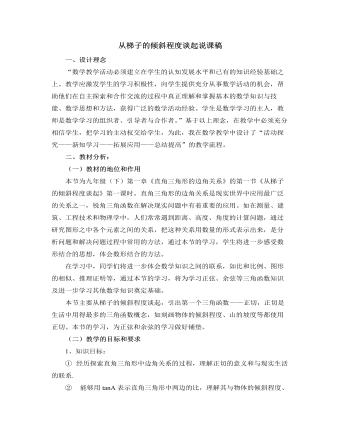
北师大版初中数学九年级下册从梯子的倾斜程度谈起说课稿
注意强调概念理解不到位的方面:① tanA是一个完整的符号,它表示∠A的正切,记号里习惯省去角的符号“∠”,若用三个字母表示角则“∠”不能省略,如“∠ABC的正切表示为tan∠ABC”;② tanA没有单位,它表示一个比值,即直角三角形中∠A的对边与邻边的比;③ tanA不表示“tan”乘以“A”。通过给出直角三角形的任两边的长,让学生求∠A,∠B的正切及时强化学生对概念的3、正切函数的应用理解通过实际问题的解答进一步了解梯子的倾斜程度、坡度与正切函数的关系;对学生进行正切的变式训练,让学生理解不管角的位置如何改变,只要角的大小不变则其正切值是不变的。练习的安插注意梯度,让不同的学生有不同的发展。4、最后小结本节课的知识要点及注意点五、达标测试具体思路:把几个问题分为四个等级,方便对学生的了解;通过评价让学生对自己的学习也做到心中有数。
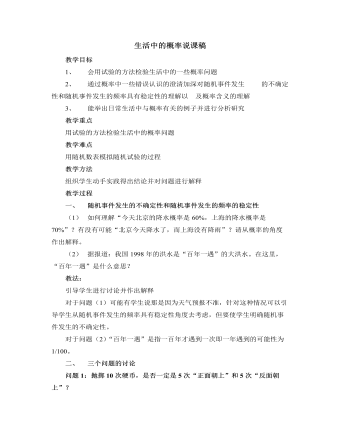
北师大版初中数学九年级下册生活中的概率说课稿
5、课本练习:P129引导学生运用随机数表来模拟试验过程并给予解答。问题2:有四个阄,其中两个分别代表两件奖品,四个人按顺序依次抓阄来决定这两件奖品的归属,先抓的人中奖率一定大吗?教法:可组织学生用试验的方法来说明问题,对于试验的结果是有说服力的,很容易使学生相信摸奖的次序对中奖的概率没有影响。问题3:彩民甲研究了近几期这种体育彩票的中奖号码,发现数字06和08出现的次数最多,他认为,06和08是“幸运号码”,因此,他在所买的每一注彩票中都选上了06和08。你认为他这样做有道理吗?教法说明:要让学生看到试验方法对试验结果的影响:1、 因为开奖用的36个球是均匀的、无差别的,所以每个号码被选为中奖号码的可能性是一样的,不存在“幸运号码”。

北师大版初中数学九年级下册圆的对称性说课稿
本节课的设计是以教学大纲和教材为依据,遵循因材施教的原则,坚持以学生为主体,充分发挥学生的主观能动性。教学过程中,注重学生探究能力的培养。还课堂给学生,让学生去亲身体验知识的产生过程,拓展学生的创造性思维。同时,注意加强对学生的启发和引导,鼓励培养学生们大胆猜想,小心求证的科学研究的思想。本节课采用教具辅助教学,旨在呈现更直观的形象,提高学生的积极性和主动性,并提高课堂效率。2、学法研究“赠人以鱼,不如授人以渔”,最有价值的知识是关于方法的知识,首先教师应创造一种环境,引导学生从已知的、熟悉的知识入手,让学生自己在某一种环境下不知不觉中运用旧知识的钥匙去打开新知识的大门,进入新知识的领域,从不同角度去分析、解决新问题,通过基础练习、提高练习和拓展练习发掘不同层次学生的不同能力,从而达到发展学生思维能力和自学能力的目的,发掘学生的创新精神。
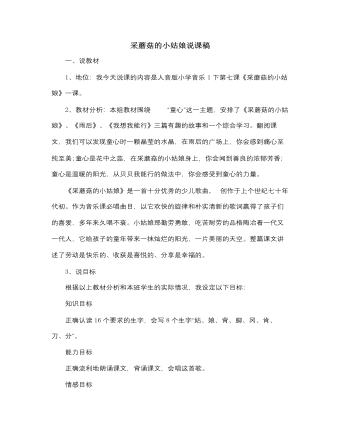
人音版小学音乐一年级下采蘑菇的小姑娘说课稿
(三)精读感悟1.独立阅读,自主探究。出示中心问题:这是一个---- 的小姑娘。?是从哪些地方看出来的?找出有关语句并体会着读一读。这一环节充分体现了学生“自主、合作、探究”的学习方式。教师为学生提供了宽广的学习空间。学生围绕中心问题,自己确定重点研究的内容,自由选择最适合自己的学习方式,在课文中摄取相关的语言信息。预设1这是一个勤劳的小姑娘,从第一小节看出。预设2这是一个善良的小姑娘,第二小节看出。引导学生找出相关的语句用自己的话说一说。设计意图1用尊重学生独特的见解和感受。让学生去关心文本中的人物,鼓励他们发表自己的想法,在品味中感受小姑娘的勤劳、善良故事表演情感升华2、学唱歌曲。帮助学生记忆课文。3、学完本课文后提问你最想说的一句话什么?你想对小姑娘说什么?达成情感目标。(四)达标测评(3)读一读,然后用“像”写句话。1.她采的蘑菇最多,多得像那星星数不清。2.她采的蘑菇最大,大得像那小伞装满筐。
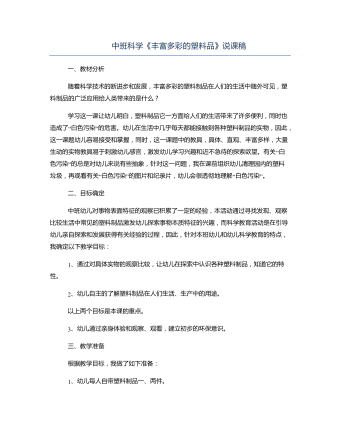
中班科学《丰富多彩的塑料品》说课稿
随着科学技术的断进步和发展,丰富多彩的塑料制品在人们的生活中随外可见,塑料制品的广泛应用给人类带来的是什么?学习这一课让幼儿明白,塑料制品它一方面给人们的生活带来了许多便利,同时也造成了“白色污染”的危害。幼儿在生活中几乎每天都能接触到各种塑料制品的实物,因此,这一课题幼儿容易接受和掌握,同时,这一课题中的教具,具体、直观、丰富多样,大量生动的实物教具易于刺激幼儿感官,激发幼儿学习兴趣和近不急待的探索欲望。有关“白色污染”的总是对幼儿来说有些抽象,针对这一问题,我在课前组织幼儿清理园内的塑料垃圾,再观看有关“白色污染”的图片和纪录片,幼儿会很透彻地理解“白色污染”。
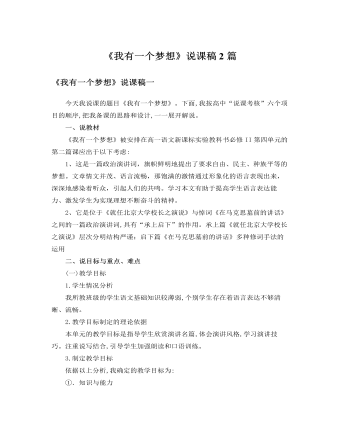
人教版高中语文必修2《我有一个梦想》说课稿2篇
(2).教学手段为了使我根据教材而设计的三个教学目标以及重点难点得以的突出和突破,达到最大化的展示境界,同时也为了配合以上我选择的四种教法得以完满实现,我决定采用“多媒体”教学手段进行全程教学。利用电脑的信息容量大,操作简便等优点,形象生动的直观展示教学内容,不但提高学习效率和质量,而且容易激发学生的学习兴趣和调动学习的积极性。四、说学法我为学生设计了三个学习方法:1.让学生学会在探究中学。通过“对黑人严酷处境的探究”和对文中重点语句的探究,培养学生在探究中学习的能力。2.让学生学会在读中学。通过“诵读法”指导学生在诵读过程中感受演讲词内在的魅力,学会在读中学。3.让学生学会在练习中学。通过“课外延伸练习法”,对所学的知识进行运用,培养学生的创新和自学能力。

新人教版高中英语必修2Unit 1 Cultural Heritage-Discovering Useful Structure教案二
This theme of the part is “ Describe people or things in greater detail”. Students have learned the grammar(restrictive relative clauses) in Book 1, and further review and consolidate its structure “prep+relative pronouns(which/whom)” and the relative adverbs(when, where and why), besides students should understand its form, meaning and functions. In this section, students should be able to express the grammar correctly in daily communication and in the writing. 1. Review the basic usages of relative pronouns and adverbs of attributive clauses . 2. Learn to use some special cases about restrictive relative clauses.3. Learn to write sentences with restrictive relative clauses flexibly according to the context.1. Review the basic usages of relative pronouns and adverbs of attributive clauses .2. Learn to use some special cases about restrictive relative clauses.3. Learn tow rite sentences with restrictive relative clauses flexibly according to the context.Step 1. Observe the following sentences, and mark the relative pronouns and the adverbs. 1. After listening to the scientists who had studied the problems, and citizens who lived near the dam, the government turned to the United Nations for help.2. Temples and other cultural sites were taken down piece by piece, and then moved and put back together again in a place where they were safe from the water.Step 2 PracticePlease complete these sentences with relative pronouns and relative adverbs and answer the following questions.Questions: 1. What is the head noun ?2. What relative words should be used ?3. What elements do they act in these sentences ?

新人教版高中英语必修2Unit 2 Wildlife Protection-Reading for Writing教案二
This lesson aims at making a poster about protecting wildlife after reading some posters. During reading students are guided to understand the content and try to summarize the posters with one sentence. Then students are guided to try to make a poster about protecting wildlife.1. Read the two posters and try to understand the summary sentences.2. Look at the two posters and try to understand what emotions they express.3. Try to summarize the features of posters4. Try to make a poster about wildlife.1. Look at the two posters and try to understand what emotions they express.2. Try to summarize the features of posters3. Try to make a poster about wildlife.Step 1 Lead inLook at the the posters on the textbook and ask:Which emotions do the posters communicate ?Step 2 Read the poster and answer the questions.1. What do you think of the animals in the poster on the left ?I think it is frightening and ugly.2. Why do we should protect the ugly animals ?All species--the good, the bad, and the ugly-- should be treated equally.The world needs all kinds--without variety, our planet cannot survive.3. Why are billions of trees being cut down every year ?To make paper for humans.4. What result will be lead to after the trees are cut down ?A lost of animal homes are being destroyed./The habitat of wildlife is being destroyed.Step 3 Find the feature of posters1. What does each poster use to stir up emotions ?On the left, it makes us a little frightened and it looks a little ugly, but it can activate our curiosity--What is it? And What is wrong with it?On the right, it makes us feel a little sad and want to protect them.
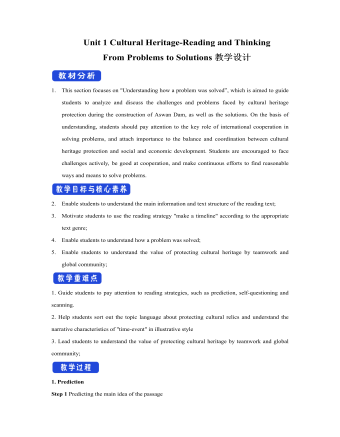
新人教版高中英语必修2Unit 1 Cultural Heritage-Reading and Thinking教案二
1. This section focuses on "Understanding how a problem was solved”, which is aimed to guide students to analyze and discuss the challenges and problems faced by cultural heritage protection during the construction of Aswan Dam, as well as the solutions. On the basis of understanding, students should pay attention to the key role of international cooperation in solving problems, and attach importance to the balance and coordination between cultural heritage protection and social and economic development. Students are encouraged to face challenges actively, be good at cooperation, and make continuous efforts to find reasonable ways and means to solve problems.2. Enable students to understand the main information and text structure of the reading text;3. Motivate students to use the reading strategy "make a timeline" according to the appropriate text genre;4. Enable students to understand how a problem was solved;5. Enable students to understand the value of protecting cultural heritage by teamwork and global community;1. Guide students to pay attention to reading strategies, such as prediction, self-questioning and scanning.2. Help students sort out the topic language about protecting cultural relics and understand the narrative characteristics of "time-event" in illustrative style3. Lead students to understand the value of protecting cultural heritage by teamwork and global community;

新人教版高中英语必修2Unit 2 Wildlife Protection-Discovering Useful Structure教案二
2.表示现阶段正在进行的被动动作(该动作在说话的瞬间未必正在进行)。Many interesting experiments are being carried out these days.(说话时,并不一定正在进行)3.表示一种经常性的被动行为,常和always,constantly 等表示频度的副词连用,这种用法常常带有赞扬或厌恶的感情色彩。He is always being praised by the leader.4.表示按计划或安排主语将要承受谓语动词所表示的动作(仅限于少数及物动词)。A party is being held tonight.Step 4 Special cases1.像take care of, look after, talk about, think of等动词与介词构成的短语用于现在进行时的被动语态时, 其中的介词不可省略。The ways to stop illegally hunting are being talked about. 2.可与部分情态动词连用,表示对正在发生的事情的推测。She may be being punished by her mother.3.有时可表示按计划或安排将要进行的一个被动动作。A celebration is being held this weekend for his success.4.某些表示“状态、心理活动、存在”等的动词,如have,want,need,love,一般不用现在进行时的被动语态,而常用一般现在时的被动语态。With the population increasing,more land is needed.5.“be+under/in+n.”可表示现在进行时的被动意义。My computer is under repair.=My computer is being repaired.

新人教版高中英语必修2Unit 2 Wildlife Protection-Reading and Thinking教案二
The theme of this unit is human and nature, focusing on the theme of wildlife protection. Nature is a complex ecosystem, in which there are delicate balance between animals and plants. Because of the role of the food chain, the extinction of one species will produce influence, causing a series of chain reaction. Large scale extinction of species will have a serious and even irreversible impact on the ecosystem, resulting in immeasurable losses. Therefore, it is of great significance to protect wild species. To protect wild species is to protect human beings themselves. The motto of this unit is "when the buying stops, the killing can too,” which is a public service advertising slogan to protect wildlife. It tells people that every rhinoceros horn, every fur, every bowl of shark fin soup, every Ivory product, and every tiger bone product, etc. consumed by human beings, are innocent wild animals slaughtered behind them. The mission of wild aid is to ban illegal trade in endangered wildlife and mitigate climate change. It aims to educate the public to reduce the consumption demand for endangered wildlife products through public publicity and improve the awareness of environmental protection.1. Improve the awareness of wildlife protection by acquiring the knowledge of wildlife protection.2. Focus on environmental protection and protection of all lives.3. Analysis of the living environment of wild animals with appropriate thinking mode.4. Skillfully use the vocabulary and grammar knowledge of this unit to cultivate self-study ability according to the unit content5. Develop cooperative learning ability through discussion and other ways1. Enable the Ss to talk about the current situation of wild animals.2. Guide the Ss to summarize the main idea of each paragraph as well as the main idea of the text.

